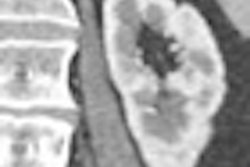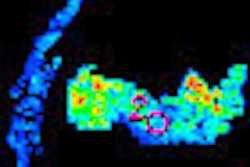A new study has found that radiologists are cutting back on the power settings used during pediatric CT scans compared to 2001 -- a sign that increased attention regarding CT radiation dose in children is having a positive effect.
Researchers from Duke University in Durham, NC, led by Dr. Michael Arch and Dr. Donald Frush, conducted a survey of pediatric radiologists and compared their answers to a previous survey conducted in 2001. The results of the current study were published in the August 2008 edition of the American Journal of Roentgenology (Vol. 191:2, pp. 611-617).
The Duke researchers describe how their 2001 research found that many children were receiving body CT scans with scanner settings meant for adults -- and most likely receiving too much radiation in the process. The current study was designed as a five-year follow-up to that research.
The hazards of radiation dose in children, namely the development of cancer, have been a well-publicized concern. In 2006, the Society for Pediatric Radiology (SPR) created the Alliance for Radiation Safety in Pediatric Imaging to raise awareness about lowering radiation dose during pediatric CT scans. That effort culminated in the launch of the Image Gently campaign in January 2008, and the alliance followed up with a meeting last month at Cincinnati Children's Hospital in Ohio to discuss ways to standardize radiation dose estimation settings and display language for pediatric CT scanning.
But despite this increased focus, no other known survey regarding routine pediatric CT scan parameters has been performed since 2001, according to Arch and colleagues. The goal of the new study was to assess the changes that have occurred in pediatric CT scans since the initial survey in 2001, with an emphasis on tube current (mA) and kilovoltage (kV), the two principle parameters that determine radiation dose.
A 27-question survey was sent to members of the SPR who specialize in pediatrics. The study contained questions that examined routine pediatric CT scan parameters, including tube current, kV, gantry rotation time, and detector collimation and pitch. The questions were specifically constructed for comparison with the 2001 survey.
Scanner settings drop
Sixty-one responses from 337 radiologists were received. Results showed that mA and kV had "decreased significantly" since 2001, especially in younger patients, who tend to be more susceptible to radiation exposure.
Nearly all respondents (98%) said they chose tube current settings based on either patient weight or age (78% and 20%, respectively), with only 2% stating that they used the same tube current for all patients regardless of weight or age.
In line with the 2001 survey, lower tube currents were used for the youngest patients, with mA increasing with age. Higher tube currents also were used in abdominal CT versus chest CT studies.
For children ages 0 to 4 years, the use of 100 mA or less increased from 42% to 97% for chest CTs and from 28% to 88% for abdominal CTs, with the use of 50 mA or less increasing from 4% to 48% for chest CTs and from 0% to 28% for abdominal CTs. No respondents reported using more than 150 mA, according to the study.
The average mA used decreased between 31 mA and 61 mA across all age groups, but the most marked decreases were observed in the youngest patients: a 54% drop in mA for chest CTs and 44% for abdominal CTs in patients ages 0 to 4 years, and 40% and 37% in patients ages 5 to 8 years.
The use of 120 kV or less was found to have increased overall from 86% to 100% for chest CTs and from 82% to 100% for abdominal CTs, with the use of 110 kV or less increasing from 4% to 48% for chest CTs and from 1% to 32% for abdominal CTs.
Despite the high percentage of radiologists using an age- or weight-based protocol, an "alarming" percentage (22%) did not know which protocol they used or skipped the question altogether, according to the researchers. An even higher percentage of respondents (up to 49%) did not know or did not complete the questions regarding tube current and kilovoltage.
In light of the concerns surrounding radiation exposure in the pediatric population, this high percentage of radiologists not familiar with their institution's protocol is "disturbing," Arch stated.
Additional findings in the study included gantry cycle time. Although this parameter was not surveyed in the 2001 study, 83% of respondents from the current study said they used rotation times from 0.4 to 0.6 seconds. Data suggest mAs would be even lower based on these lower rotation times, according to the researchers.
Other techniques for reducing radiation include collimator setting and pitch. Although it is harder to determine radiation dose differences between thick and thin collimations, 17% of respondents used the thinnest possible collimation for chest CTs and 13% did so for abdominal CTs. Larger pitches deliver less radiation: 17% of respondents used a pitch of 0.50 to 0.99 for chest CTs and 10% did so for abdominal CTs.
Arch noted that the study's main limitation was the large number of respondents who did not complete the follow-up survey. Additional study limitations included the polling of only SPR members, the arbitrary grouping of patients by age and weight, the discrepancy between 2001 parameters versus those of 2006, and the inability of researchers to determine to what extent radiation dose was decreased.
Another limitation was that the study did not fully assess whether CT scans were being used "more indiscriminately" during the first five years after the 2001 survey.
By Caitanya Min
AuntMinnie.com contributing writer
September 4, 2008
Related Reading
Meeting to examine pediatric CT dose, August 18, 2008
FDA posts pediatric imaging advisory, June 25, 2008
House resolution advocates lower pediatric x-ray dose, May 27, 2008
CT experts grapple with rising concerns about radiation dose, May 14, 2008
Study evaluates radiation dose, cancer risk for whole-body PET/CT, May 9, 2008
Copyright © 2008 AuntMinnie.com




















